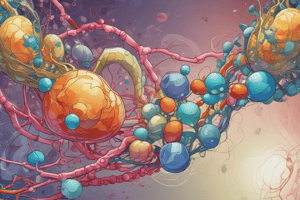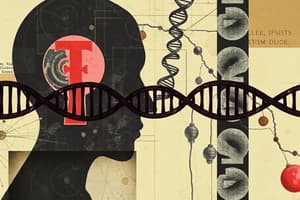Podcast
Questions and Answers
Which scientist coined the term 'plasmid'?
Which scientist coined the term 'plasmid'?
- James Watson
- Francis Crick
- Gregor Mendel
- Joshua Lederberg (correct)
What is the function of plasmids in bacteria?
What is the function of plasmids in bacteria?
- To provide antibiotic resistance
- To carry genes that benefit the survival of the organism (correct)
- To replicate independently of chromosomal DNA
- To exchange genes through bacterial conjugation
What is the copy number of plasmids in a single cell?
What is the copy number of plasmids in a single cell?
- Always one
- Four
- Varies from one to several hundreds (correct)
- Depends on the size of the cell
What is the purpose of CsCl density gradient centrifugation in isolating plasmids?
What is the purpose of CsCl density gradient centrifugation in isolating plasmids?
Which of the following is a hazardous and volatile chemical used in the PCR experiment?
Which of the following is a hazardous and volatile chemical used in the PCR experiment?
What is the purpose of using a carrier like glycogen in the precipitation step of the PCR experiment?
What is the purpose of using a carrier like glycogen in the precipitation step of the PCR experiment?
Which temperature is typically used to denature DNA molecules in PCR?
Which temperature is typically used to denature DNA molecules in PCR?
What is the purpose of site-directed mutagenesis in molecular biology?
What is the purpose of site-directed mutagenesis in molecular biology?
Which technique is used to assess whether real-time PCR assays have produced single, specific products?
Which technique is used to assess whether real-time PCR assays have produced single, specific products?
What is the temperature at which 50% of DNA is denatured known as?
What is the temperature at which 50% of DNA is denatured known as?
What is the process of synthesizing single-stranded DNA using single-stranded RNA as a template called?
What is the process of synthesizing single-stranded DNA using single-stranded RNA as a template called?
What is the Ct value in real-time PCR?
What is the Ct value in real-time PCR?
Which of the following is a disadvantage of qPCR?
Which of the following is a disadvantage of qPCR?
What is the formula to calculate fold change in gene expression using qPCR?
What is the formula to calculate fold change in gene expression using qPCR?
What is the purpose of adding a pH indicator in colorimetric LAMP?
What is the purpose of adding a pH indicator in colorimetric LAMP?
What is the principle behind pyrosequencing?
What is the principle behind pyrosequencing?
Which of the following methods can be used to break apart cells and release their inner contents?
Which of the following methods can be used to break apart cells and release their inner contents?
What is the purpose of separating DNA by Cesium Chloride?
What is the purpose of separating DNA by Cesium Chloride?
What happens to RNA during the separation process using Cesium Chloride?
What happens to RNA during the separation process using Cesium Chloride?
What is the purpose of loading a sample mixed with Cesium Chloride into an ultracentrifuge?
What is the purpose of loading a sample mixed with Cesium Chloride into an ultracentrifuge?
Which of the following is a reason why continued thermal cycling does not lead to the production of significant amounts of product anymore?
Which of the following is a reason why continued thermal cycling does not lead to the production of significant amounts of product anymore?
What is the purpose of using a fluorescent marker in real-time PCR?
What is the purpose of using a fluorescent marker in real-time PCR?
Which detection method in real-time PCR relies on the intercalation of a dye with the DNA double helix?
Which detection method in real-time PCR relies on the intercalation of a dye with the DNA double helix?
How does the hydrolysis probe technique in real-time PCR generate fluorescence?
How does the hydrolysis probe technique in real-time PCR generate fluorescence?
Which enzyme is responsible for degrading nucleotides in the reaction mixture?
Which enzyme is responsible for degrading nucleotides in the reaction mixture?
Which substrate is added to the reaction mixture along with Adenosine 5’ phosphosulfate (APS)?
Which substrate is added to the reaction mixture along with Adenosine 5’ phosphosulfate (APS)?
Which nucleotide is added to the reaction mixture in pyrosequencing?
Which nucleotide is added to the reaction mixture in pyrosequencing?
What is released when DNA polymerase catalyzes the incorporation of a complementary nucleotide?
What is released when DNA polymerase catalyzes the incorporation of a complementary nucleotide?
What is the limitation of pyrosequencing when it comes to detecting homopolymeric regions?
What is the limitation of pyrosequencing when it comes to detecting homopolymeric regions?
What triggers a series of enzymes in pyrosequencing?
What triggers a series of enzymes in pyrosequencing?
Flashcards are hidden until you start studying
Study Notes
Plasmids and Their Functions
- The term 'plasmid' was coined by American geneticist Joshua Lederberg.
- Plasmids function primarily as vehicles for gene cloning in bacteria, allowing for the transfer of genetic material.
- The copy number of plasmids in a single bacterial cell can range from a few to several hundred.
CsCl Density Gradient Centrifugation
- CsCl density gradient centrifugation is used to isolate plasmids by creating a gradient where plasmids can be separated based on their buoyant density.
- During this process, RNA tends to form a separate layer and is effectively separated from DNA.
PCR and Related Techniques
- Hazardous and volatile chemicals used in PCR include substances like dimethyl sulfoxide (DMSO).
- Glycogen is used as a carrier in the precipitation step of PCR to increase the yield of DNA during extraction.
- The denaturation temperature for DNA molecules in PCR is typically around 94-98°C.
Site-Directed Mutagenesis
- Site-directed mutagenesis allows for the precise modification of specific DNA sequences to study gene function.
Real-Time PCR
- Real-time PCR is assessed for producing single, specific products using melting curve analysis.
- The temperature at which 50% of DNA is denatured is termed the melting temperature (Tm).
- The Ct (threshold cycle) value indicates the cycle number at which fluorescence exceeds a threshold level, reflecting the quantity of target DNA.
qPCR Limitations
- A common disadvantage of qPCR is its potential for non-specific amplification and inaccurate quantification.
Gene Expression Analysis
- Fold change in gene expression using qPCR can be calculated using the formula: Fold Change = 2^(ΔCt).
- A pH indicator is used in colorimetric LAMP to reveal the presence of target DNA through a color change.
Pyrosequencing
- Pyrosequencing relies on the release of pyrophosphate during DNA synthesis to generate a light signal for nucleotide detection.
- A limitation of pyrosequencing is its difficulty in accurately detecting homopolymeric regions due to signal saturation.
Enzyme Activity in Reactions
- In the reaction mixture, nucleotides are degraded by enzymes such as exonucleases.
- Adenosine 5’ phosphosulfate (APS) is typically used alongside the nucleotide substrate in processes like pyrosequencing.
Centrifugation and DNA Separation
- Loading a sample mixed with CsCl into an ultracentrifuge allows for the separation of molecules based on density, resulting in purified plasmids or DNA.
- Continued thermal cycling in PCR may yield minimal product due to depletion of reagents or accumulation of inhibitory byproducts.
Fluorescent Markers and Detection in PCR
- Fluorescent markers in real-time PCR enable real-time monitoring of DNA amplification through emitted fluorescence during reactions.
- The intercalation of a dye with DNA double helix is the principle of SYBR Green detection methods in real-time PCR.
- The hydrolysis probe technique generates fluorescence as a result of the cleavage of a probe upon amplification of the target DNA.
Studying That Suits You
Use AI to generate personalized quizzes and flashcards to suit your learning preferences.




